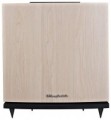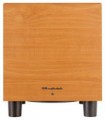Acoustic design
—
Closed type. The simplest type of construction: a closed (sometimes hermetically sealed) case with a speaker placed on the front panel. It is believed that such subwoofers have low sensitivity, which, however, is offset by high sound transmission accuracy and low distortion.
—
Phase inverter type. In the cases of such subwoofers, a tube is installed that has an outlet to the surrounding space. The length of the tube is chosen so that a signal comes out of it, inverted in phase relative to the signal from the front of the cone (in other words, from the main speaker). This improves the sound of the subwoofer and enhances the sound pressure. The disadvantage of a phase inverter is the additional noise from the sound stream in the tube.
—
With a passive radiator. A design similar to a phase inverter (see above) in terms of purpose and principle of operation, however, instead of a tube, such subwoofers use the so-called passive emitter. In fact, it is an ordinary speaker, devoid of a coil and a magnet and playing the same role as the phase inverter tube. The use of a passive radiator allows you to get rid of the noise of the air flow, characteristic of phase inverters.
Power
Rated power of the subwoofer. Technically, this is the highest average (rms) sound power at which the device can work normally (without sound distortion and damage to components) for an unlimited time. Simply put, the more powerful the subwoofer, the louder it is. The choice for this parameter depends primarily on the size of the space / room that is planned to be covered; detailed recommendations for different situations can be found in special sources.
Also, the power is directly related to the characteristics of the amplifier used with the subwoofer. For active subwoofers (see "Type"), this item actually indicates the nominal power of the built-in amplifier; the speaker itself can be more powerful, but it doesn't matter anymore. For passive models, the power rating corresponds to the highest amplifier power that can be connected to the speaker without the risk of damaging it at high volume.
Sensitivity
The sensitivity value determines the volume of the subwoofer when an external signal of a certain power is connected to it. The higher the sensitivity, the louder the sound will be, with equal signal power and impedance.
Frequency range
The range of audio frequencies reproduced by the subwoofer. As a general rule, the wider the frequency range, the richer the sound and the more detail the speaker can convey. However, it is worth remembering that subwoofers as a class are designed for low and ultra-low frequencies in the range from 20 to 150 (sometimes 200) Hz. Therefore, in fact, a significant difference in sound is noticeable only with a large difference in the reproducible ranges (for example, 20-200 Hz and 50-150 Hz).
Also, do not forget that an extensive frequency range is not yet a guarantee of high-quality sound; and in some cases (for example, if the main speakers of the speaker also cope well with low frequencies), it may be completely redundant.
Crossover frequency
Cutoff frequency of the crossover installed in the subwoofer (or supplied with it — for passive models, see "Type").
The crossover splits the audio signal into separate frequencies so that only the bass goes to the subwoofer and only the main range goes to the speakers. Such a device is mainly equipped with home models (see above). And the crossover frequency is the upper threshold of the frequencies fed to the subwoofer. This information is important for matching with the rest of the speakers: ideally, the lower threshold of the main acoustics should correspond to the upper threshold of the subwoofer, otherwise the frequencies will either overlap or dip in them (neither of which contributes to sound quality). For the convenience of matching, the crossover can be made adjustable (see above).
Inputs
Types and number of inputs provided in the design of the subwoofer. There can be several audio inputs of the same type — this is usually provided for signal switching (for example, to transmit sound to the rest of the acoustics through the built-in subwoofer crossover).
—
RCA (LFE). Dedicated input for connecting a low-frequency audio signal from a preamplifier; in fact, LFE means "low-frequency effects", and RCA is a type of connector (colloquially referred to as "tulip"). It is desirable to connect a signal to such an input from a specialized output “to a subwoofer” or from an external crossover. Note that the LFE input can be provided even in a subwoofer equipped with its own frequency filter: external crossovers often turn out to be of better quality than built-in ones. Most models with this output are domestic (see "Intended use").
—
RCA (linear). Input used to connect the audio signal from the preamplifier. At the same time, unlike the LFE described above, we are talking about all audio frequencies, and not just about bass. The presence of such a connector, usually, indicates the presence of a built-in crossover; also line inputs can be used for audio signal switching, including without processing it (if there are appropriate outputs, see below). Note that in analogue RCA, one connector is needed for each audio channel, so the specific number of connectors may be different; howev
...er, most often there are two of them — for a stereo signal.
— Jack (6.35 mm). Socket for 6.35 mm Jack. This interface is used to connect to both a preamplifier and a power amplifier; it is especially popular in professional studio equipment, although it is also found in other types of audio equipment, including home and concert. The 6.35 mm Jack provides good connection quality, connects and disconnects quickly (although the lack of a lock slightly reduces reliability), and can also be used for balanced audio (see "Balanced XLR" below), although support for this feature in each individual case should be clarified separately. at the same time, there are combo connectors that allow you to connect one of the plugs — Jack (6.35 mm) or XLR.
— Balanced XLR. Distinctive round 3-pin locking connector used for balanced analogue audio preamp connection. The peculiarity of this connection is that, due to the specific method of signal transmission, the cable itself plays the role of an interference suppressor, which allows the use of rather long wires without compromising the purity of the sound. Because of this, as well as the reliability of the connection, XLR has become very popular in high-end audio equipment, including studio and live equipment. One connector of this type is responsible for one channel of sound, therefore, in subwoofers with support for stereo signal switching, the XLR input can consist of 2 connectors; this may be specified in the specifications.
— Balanced digital ( AES/EBU). Professional interface for digital audio transmission. It uses the same connector and cable as the balanced XLR described above, but differs in signal type (besides, all channels are transmitted via one connector with this connection). At the same time, AES/EBU has all the advantages of a balanced connection, including high noise immunity even with long cable lengths. To reproduce such an audio signal on the subwoofer itself, it is necessary that the latter has not only an amplifier, but also its own DAC, which greatly complicates and increases the cost of the design. In addition, AES/EBU outputs are found mainly in high-end professional audio equipment. Thus, subwoofers with such an input are extremely rare, mainly among advanced models for studio and concert purposes. And even in such models, only the switching of a digital signal to a similar output can be provided, and not its reproduction.
— Speakon. Connector used in professional audio equipment to connect to a power amplifier. Its specific features are the ability to work with high currents and increased protection from human contact with live parts. This made the Speakon very popular in live gear; however, there are also home subwoofers (see "Intended use") with such inputs.
— High-level(terminals). Input for connecting a signal from a power amplifier. It is one of the most popular connection interfaces for passive subwoofers (see "Type"), however, it can also be provided in active ones — in case an external bass amplifier is available, better than the built-in one. One input provides a pair of terminals and allows you to transmit one channel of sound — this is enough when connecting a subwoofer to an external crossover. However, there can be two high-level inputs (and four terminals, respectively) — this means that the audio signal can be transmitted to the rest of the audio system components through the built-in crossover.
— Trigger. Service input used to automatically turn on the subwoofer. It is enough to connect the corresponding output of another audio system component (for example, an audio receiver) to the trigger input — and each time this component is turned on, the “sub” will receive a control signal and turn on too, which will save the owner from having to “wake up” the device separately.
